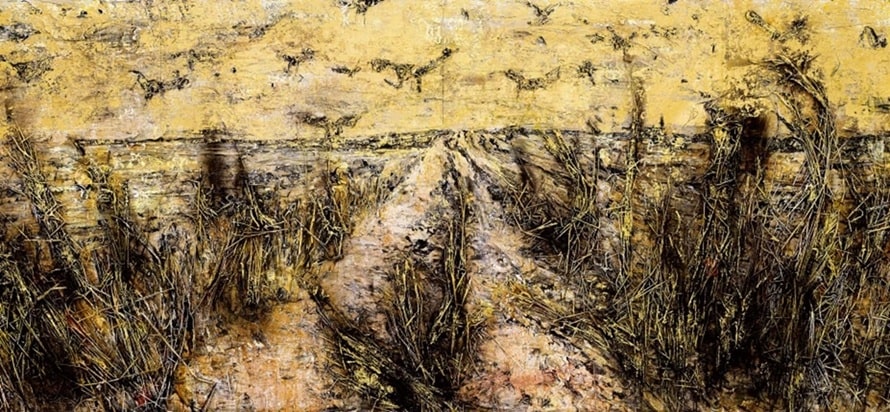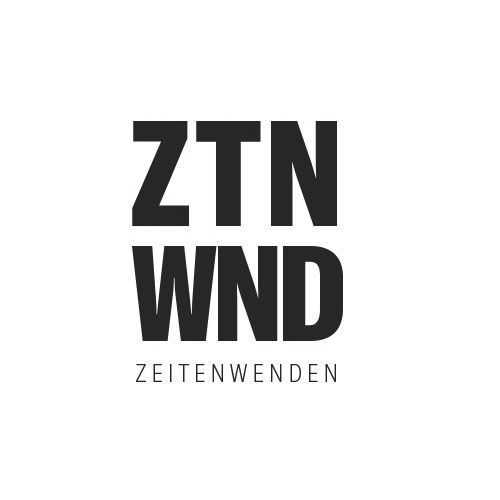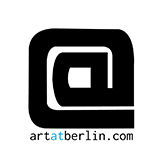Vincent van Gogh has had an enduring influence on Anselm Kiefer Hon RA (Honorary Royal Academician) over the artist’s nearly 60-year career. The Royal Academy of Arts presents work by both artists, exhibited side by side for the first time in the UK. The exhibition brings together paintings and drawings by Van Gogh from the collection of the Van Gogh Museum, Amsterdam, with paintings, drawings and sculptures by Kiefer, including new work that has never been shown before. The presentation reveals similarities of thought, process and subject matter shared by the two artists but also reflects noticeable differences, offering visitors a new insight into both artists’ work.
Image above: Anselm Kiefer, The Crows (Die Krähen), 2019. Emulsion, oil, acrylic, shellac, gold leaf, straw and clay on canvas, 280 x 760 cm. Courtesy of the artist and White Cube. Photo: Georges Poncet. © Anselm Kiefer.
Van Gogh was Kiefer’s first artistic inspiration. Kiefer first encountered Van Gogh’s work at age 18 when he received a travel grant to follow in his footsteps, starting in the Netherlands, through to Belgium, Paris and Arles, in the south of France. During his travels, Kiefer produced drawings inspired by Van Gogh and was profoundly influenced by the rational structure and compositional clarity of Van Gogh’s landscapes. Throughout Kiefer’s career, the pioneer of Post-Impressionism has informed the subjects and techniques of Kiefer’s monumental paintings and sculptures which draw on history, mythology, literature, philosophy and science.
Highlights of the exhibition include a selection of Kiefer’s celebrated large-scale landscapes, including The Crows (Die Krähen), 2019 (Courtesy of the Artist and White Cube) and Nevermore, 2014 (Courtesy Eschaton Foundation). These monumental works clearly encapsulate Kiefer’s admiration for compositional devices used by Van Gogh, through his adoption of high horizon lines, close-up imagery combined with deep perspectives and panoramic formats. They also reflect shared motifs of crows and wheatfields and a deep affinity towards painterly surface textures. Juxtaposed with seminal landscapes by Van Gogh, including Snow-Covered Field with a Harrow (after Millet), 1890 (Van Gogh Museum, Amsterdam (Vincent van Gogh Foundation)) and Field of Irises near Arles, 1888 (Van Gogh Museum, Amsterdam (Vincent van Gogh Foundation)), the exhibition allows visitors to consider Van Gogh’s enduring influence on Kiefer’s practice.
The exhibition also features drawings by both artists. The drawings Kiefer produced in his youth, inspired by Van Gogh during his journey in his footsteps, are presented alongside several of Van Gogh’s own drawings. La Crau Seen from Montmajour, 1888 (Van Gogh Museum, Amsterdam (Vincent van Gogh Foundation)), last exhibited in London over 50 years ago, is one of his most remarkable, both owing to its large size, analogous to paintings, and to the fact that it is not preparatory or derived from a painting, but produced as an autonomous composition; a work of art in its own right.
Further highlights include Walther von der Vogelweide: under der Linden an der Heide (Walther von der Vogelweide: under the Lime tree on the Heather), 2014 (Courtesy of the artist and White Cube), a recent work by Kiefer, which has never been exhibited before, and a new sculpture created for the exhibition, depicting a tall sunflower emerging from a large pile of books, shedding golden seeds onto their lead pages. The sculpture is shown in dialogue with Van Gogh’s Piles of French Novels, 1887 (Van Gogh Museum, Amsterdam (Vincent van Gogh Foundation)) and visualises the importance of literature and poetry to both artists; Van Gogh was one of the most well-read artists of the 19th century, and Kiefer makes words and literary references visually present in his work. Lastly, The Starry Night (De sterrennacht), 2019 (Courtesy of the Artist and White Cube), a monumental canvas of straw, gold leaf, and sediment of electrolysis by Kiefer leaves visitors with a lasting impression of his resounding admiration of Van Gogh through his interpretation of the iconic Starry Night.
WHEN?
Ab Saturday, 28. June until Sunday, 26. October 2025
Opening hours:
Tuesday to Sunday: 10 am – 6 pm
Friday: 10 am – 9 pm
WHERE?
Royal Academy of Arts
Burlington House
Piccadilly, London W1J 0BD
COSTS?
Regular: £17






